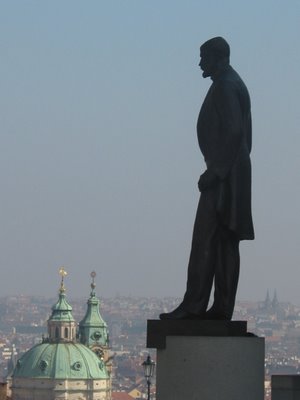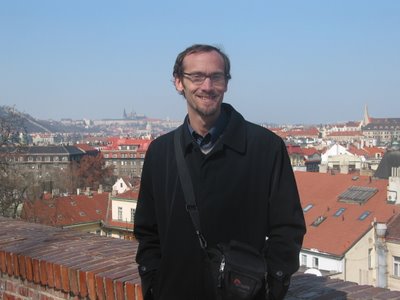Prague Spring



That title was too good to pass up.
Because of technical difficulties, the need to still work, a few visitors, and various demonstrations I have fallen desperately behind in my blog postings. A few readers have emailed me about my trip last month and I need to oblige…
Through circumstance and connections I went to Prague for a long week-end last month. Like my trip to Verdun it was not a long-planned trip but it was a city that I had heard great things about and wished to visit at some point. I had never traveled to Central Europe or visited a former Soviet-bloc state and this was an opportune situation. A friend of mine, David, is an American expatriate working on his doctorate in ecology and has lived in Prague seven of the last twelve years and speaks fluent Czech. He had a free window of time and a hide-a-bed and I had a credit card so I booked a flight in late February.
European air travel reminds me of air transport in the US in the early 1980s: it is still the province of the middle classes and above. Train transport is cheaper for the most part, and while often not faster, remains king of travel options in Europe. Intra-European air travel does not see the cattle-car type feeling one gets in Atlanta, Chicago, or Dallas, or any of the other super-terminals in the States. I flew out of Charles De Gaulle in Paris on a mid-Friday afternoon and had arrived early for fear of long lines but I had the feeling of traveling out of a much smaller city and terminal due to the lack of crowds. There was one brief moment of panic though for as I arrived at the multi-terminal airport at Charles de Gaulle I could not find my gate as the bank of six departure monitors (in a row arranged by the half hour) for my particular half hour monitor was not working and there were no clues as to which gate or terminal (CDG has six terminals) I should take. No person of authority was nearby and CDG is not like an American airport with a bank of monitors every fifty feet. At CDG they just have one set of monitors in every terminal. I chose a terminal at random and after a half mile walk I found that I chose the wrong one…a quick scramble and a shuttlebus and some nervous moments found me at the correct gate.
I arrived right on time in Prague after a brief layover in Zurich and a stunning view of the Alps from the air. Winter was still clinging to Prague as the city had actually seen a few inches of snow that morning. My trip through customs took all of five minutes and I met David and he drove us back to the heart of Prague. We briefly stopped at his apartment to drop off my bag and then we headed out to a Prague pivensa, or a pub for dinner and a few beers (just a few, I promise). The Czech Republic, formed of the two provinces of Bohemia and Moravia, is the European king of beers and has the highest per capita consumption in the world. I can understand why as the beer certainly is delicious there, and, compared to France, ridiculously inexpensive.
Of course, the Czech Republic is more important for other reasons. The Czechs are a Slavic people, having arrived in Europe like so many others as semi-nomadic invaders in the first millennium. During the Middle Ages the Czechs built a powerful and important European kingdom based around Prague and the large Vltava River that bisects the city. By the 1300s, Prague was one of the largest and wealthiest cities in Europe boasting a massive Gothic cathedral, a university, and a prosperous urban middle class. Also, the Czech rulers followed a mostly tolerant policy toward it Jewish inhabitants so a Jewish quarter arose in the city. This wealth, however, attracted larger and more powerful neighbors and as was the case for so many middle-size powers, the larger Austrian Empire took over the Czechs, ruling over them for some four hundred years. While the relationship between England and Ireland is not exactly the same, one could see the Austrians ruling the Czechs much as the British ruled the Irish: The Habsburg Austrians administered the people with a harsh Germanic efficiency that saw the Germanization of the Slavic people in terms of language, culture, and religion. The Vltava became the Moldau, Plzen became Pilsen, Brno became Brun, and so on. The Catholic Austrian rulers worked hard to reduce the influence of the proto-Protestant Jan Hus and the Hussites who were so influential in the 1400s.
Even during this “foreign” rule, Czech culture flourished and prospered and the area never lost the totality of its own traditions. One can certainly see this in architecture with a number of onion-domed buildings that reminded one of the Kremlin as the architecture is a mix of both West and East. Prague had the good fortune of missing physical damage during the Second World War and as a result the city is a living architecture class.
In fact, I have never visited a city that pays so much detail to architecture: even the most mundane apartment block has some redeeming architectural flourish or embellishment. Friezes, sculptures, mosaics, paintings, nearly every building had some aspect of one of these (or all of these).
Of course, the Czechs have more history to tell. At the end of the Great War, out of the wreckage of Austrian Empire, the Czechs and Slovaks formed an independent state of which nationalists had longed dreamed. From 1919-1938, Czechoslovakia was a vibrant and prosperous democracy in Central Europe. Even as neighboring countries turned to either Fascism or dictatorships, Czechoslovakia remained democratic. Sadly, however, the French and English sacrificed the young country on the altar of appeasement to Hitler and before the Second World War Nazi Germany took over and dismantled the country, turning it once more into a servile appendage. Much of the Jewish population died during the Holocaust or fled the country. The end of the war saw democracy briefly restored but by 1948 Soviet influence saw a Communist dictatorship emerge and for over forty years the East now ruled the Czechs.
Nineteen sixty-eight saw hope emerge in Czechoslovakia as the reform-minded Premier, Alexandr Dubcek started a policy of “openness” (or “Communism with a human face”) that proceeded Gorbachev’s similar policy of glasnost by nearly twenty years. The “Prague Spring” of 1968 was the first challenge to the Soviet state since the Hungarian uprising in 1956 and Czechs believed that this was their chance. Sadly, Brezhnev of the USSR brooked no opposition and in the summer of 1968 forces from other Warsaw Pact countries invaded to “restore order.” A Prague university student, Jan Palach, reminiscent of the later bravery of the man with the shopping bag facing the tanks in Tienamen Square in 1989, set himself on fire to protest the invasion. He died of his wounds three days later. The Prague Spring turned into winter once more for twenty more years until the people-powered “Velvet Revolution” of 1989 overthrew the Communist regime and restored democracy.
One could now say that the Czech Republic is facing a new invasion: that of tourists and of the West. One difficulty with visiting Prague is that it is has been “discovered” in the last fifteen years. As my friend Ross says, once Fodor’s Guide Books discovers you it is all over. Prague in some sense has it all: a central and compact location, cheap prices (compared to Western Europe things cost nearly half), and a friendly populace eager for tourist dollars. As a result Prague has become a tourist Mecca and even visiting the last days of winter and the first day of spring I found there to be a larger number of tourists than I would have believed. I asked my host what the summers were like and he said that he just avoids the old town entirely as the crush is so overwhelming.
Of course, I am a tourist as well in Prague but the sheer numbers and weight of them already seemed oppressive as tour buses disgorged throngs in what I only can describe as “industrial tourism.” We wandered by the main sites but went inside none as I had no taste to be in a cathedral location that would feel more like a train station than anything else. Groups and individuals had their virtual checksheets of physical locales to mark of their lists of “have-to-sees” without having any context in which to base their observations. When the requisite hour was spent at the church, cathedral, or museum (with most of that time spent at the gift shop) the drones moved en masse to their next destination to repeat the experience. Experience with the “locals” would be waiters and hotel clerks. Once home, the checksheet of cultural “accomplishments” could be brought to work to lord over other neighboring and disinterested cubicle drones to show their cultural superiority in a touristic armsrace (for an extreme example, see Jon Krakauer’s “Into Thin Air”). As a result, part of Prague had the feel of a European Epcot center: Czech culture and history had been successfully distilled, packaged, and covered with plastic (for your protection)
The unbridled rush to capitalism (see the film about post-Soviet East Berlin called “Good-bye Lenin”) in some parts of the town are a bit evident for in some areas new McDonalds and KFC can been seen sprouting up in neighborhoods where they clearly do not “fit.” However, in some sense, that made Prague seem a bit more real: at least the “future” could have a place beside the heavily marketed past. The Czechs feel a sense of optimism though and the general mentality is that with joining the EU (and to be on the Euro in the next few years) living standards and quality of life will equal that of Germany and Austria to the West within the next decade. Sadly, I saw many beggars in the streets, many taking the position of a silent medieval supplicant, prostrate on the ground, head bowed with a bowl in front of them for donations.
David and I did visit one small exhibition off the beaten path—a small display of photographs taken in former Soviet non-Russian Republics. Nearly all of the fifty or so photos showed those living on the margins in those areas: Steel workers in Kazakhstan, semi-nomads in Uzbekhistan, homeless in Moldavia and the like. It was simple, thought-provoking, and wonderful. Furthermore, it cost $1.50 and one other person was there. Now, that’s the type of tourism for me!


3 Comments:
This comment has been removed by a blog administrator.
Clark, your history lessons always catch and keep my attention...too bad more professors don't teach with that spark of intellect with a dash of humor. It's so sad to see the wonderful history and natural beauty of a country start to dismantle due to tourism. Thanks once again for the updates...always such a fun daydream of a read while a work!
Katie :)
Excellent, love it!
» » »
Post a Comment
<< Home